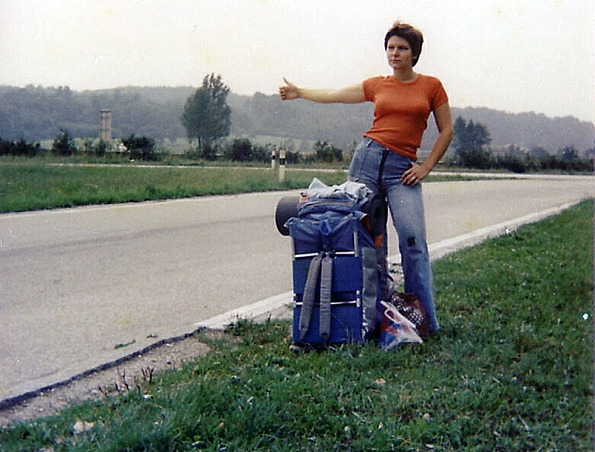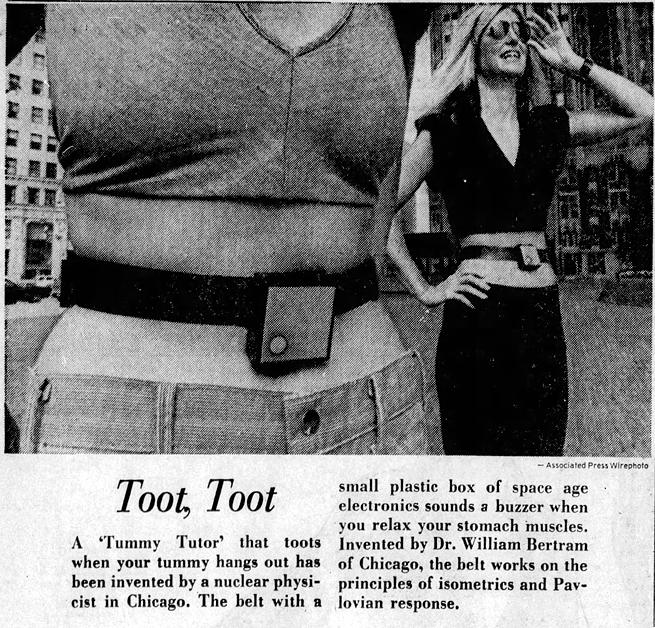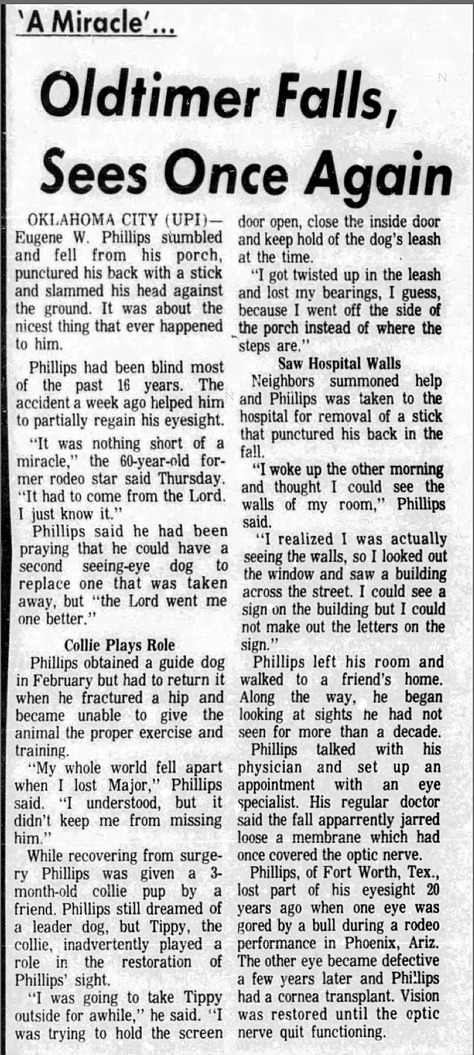1970s
Tarantula security guards
In the mid-1970s, there was a fad among jewelry stores to use tarantulas as security guards. Stores claimed it helped prevent thefts, although tarantulas aren't going to do much to stop a thief, besides looking scary. Rattlesnakes, I imagine, might work better.
La Crosse Tribune - July 19, 1975

Posted By: Alex - Fri May 08, 2020 -
Comments (5)
Category: Crime, Insects and Spiders, 1970s
Staring Hitchhikers
Will hitchhikers get more rides if they stare at oncoming drivers or if they look away? A 1974 study published in the Journal of Applied Social Psychology attempted to answer this question:In the stare conditions, E stared at the driver of the target vehicle and attempted to fixate on the driver's gaze and maintain this gaze as long as possible until the driver either stopped his vehicle or drove on. In the comparison conditions, E looked anywhere else but at the driver. Thus, on some trials E looked in the general direction of the car; on other trials E looked at his feet, the road, the sky, etc. Es were specifically instructed to neither smile nor frown, and to maintain a casual (neither rigid nor slouching) body postural orientation while soliciting rides.
The two hitchhikers were described as, "both 20 years of age and both dressed in bluejeans and dark coats. The male had short, curly blond hair, and the female, straight, shoulder length blond hair. Both could be described as neat, collegiate, attractive in physical appearance, and of an appropriate age to be hitchhiking."

A hitchhiker in Luxembourg - Aug 1977 (source: wiktionary.org)
(not one of the hitchhikers in the study)
Staring is often interpreted as a threat. So the researchers anticipated that staring at oncoming drivers might result in fewer rides. But the opposite turned out to be true. Which is a useful tip to know if you ever need to hitchhike. But what really helped get a lot of rides was being a single female. From the study:
Contrary to popular belief and hitchhiking folklore , it was no easier for a male-female couple to hitch a ride than a single male, and a mixed sex couple was less successful at soliciting rides than a single female hitchhiker. Although the generality of this conclusion is limited by the fact that it is based upon results obtained by one male and one female E, it is probably the case that couples are less successful hitching rides because of space limitations in the cars they approach. That is, it is more likely that the driver will have room for one additional passenger than that he will have room for two or more additional passengers in his car.
Incidentally, the experimenters never actually ever got in a car with anyone: "After a motorist stopped to pick up one of the hitchhikers, he was politely thanked and given a printed description of the nature of the experiment. No driver expressed any discomfort when he learned that the hitchhiker did not actually want a ride."
Posted By: Alex - Mon May 04, 2020 -
Comments (5)
Category: Science, Experiments, Psychology, 1970s, Cars
The Tummy Tutor
It also went by the name "Belly Beeper". The idea was that if you slouched or let your stomach out, it would start beeping. Supposedly this would train you to always keep your stomach muscles tensed and not slouch.Either that or it would train you to avoid wearing it.

The Miami Herald - Oct 7, 1973
Posted By: Alex - Tue Apr 21, 2020 -
Comments (2)
Category: Inventions, 1970s, Dieting and Weight Loss, Stomach
Magneto and Titanium Man
So far as my researches at ISFDB reveal, Marvel Comics has inexplicably never used this song in a film. WU hereby offers it, gratis, for the relaunch of the X-Men.
Posted By: Paul - Tue Apr 21, 2020 -
Comments (2)
Category: Movies, Music, Comics, 1970s
She was boring her husband to death
This ad for Vivarin stimulant tablets ran in newspapers and magazines in 1971. It prompted a complaint from the FTC.
San Bernardino Sun - Mar 28, 1971
Ivan Preston provides more details in The Great American Blow-Up: Puffery in Advertising and Selling:
"One day it dawned on me that I was boring my husband to death. It was hard for me to admit it—but it was true…. Often by the time he came home at night I was feeling dull, tired and drowsy, and so Jim would look at television and, for the most part, act like I wasn’t even there. And I wasn’t. I decided that I had to do something. I had seen an advertisement for a tablet called Vivarin. It said that Vivarin was a non-habit forming stimulant tablet that would give me a quick lift. Last week… I took a Vivarin tablet… just about an hour before Jim came home, and I found time to pretty up a little, too. It worked. All of a sudden Jim was coming home to a more exciting woman, me… The other day—it wasn’t even my birthday—Jim sent me flowers with a note. The note began: ‘To my new wife…'"
All very nice, but but the contribution of Vivarin was to provide merely the amount of caffeine found in two cups of coffee. No miracle aphrodisiac, just good old caffeine at a premium price!
The major allegation of the FTC's complaint about Vivarin concerned this social-psychological misrepresentation... But the Vivarin ads were also alleged to be deceptive because they did not disclose caffeine to be the critical ingredient.
Posted By: Alex - Mon Apr 20, 2020 -
Comments (3)
Category: Drugs, Advertising, Wives, 1970s
Six Minutes of Disco Dancing
So much polyester. So many fly ladies. So many dudes in jumpsuits. So many funky moves.
Posted By: Paul - Sun Apr 19, 2020 -
Comments (3)
Category: Fashion, Music, 1970s, Dance
‘Accident forced him to turn gay’
There's a recurring theme in weird news of people whose sexual behavior changes dramatically following accidents. The most famous case is the so-called Cable Car Nymphomaniac.And then there's Carmon Leo, who suffered a back injury in an auto collision, and subsequently (despite swearing he was totally heterosexual before) "started hanging around gay bars and reading homosexual literature." In 1976, a jury awarded him $200,000, and gave his wife $25,000 as well.

Akron Beacon Journal - Feb 15, 1976
Posted By: Alex - Sat Apr 18, 2020 -
Comments (1)
Category: 1970s, Sex
Keyboard Cat, 1975
Fatso the cat became famous online as "Keyboard Cat".
And back in the pre-Internet days, Shangai the cat was also known for her skills at the keyboard.

Hagerstown Morning Herald - Feb 7, 1975
Posted By: Alex - Thu Apr 16, 2020 -
Comments (0)
Category: Cats, 1970s
Regained sight after fall
Another case of an improbable cure.Eugene W. Phillips, 60, had been blind for 16 years. Then, in August 1972, he fell off his back porch, puncturing his back with a stick and hitting his head on the ground. But he also partially regained sight in one eye. His doctor concluded that the fall had jarred loose a membrane that had been covering the optic nerve.

Bonham Daily Favorite - Aug 8, 1972

Provo Daily Herald - Aug 9, 1972
Related:
Posted By: Alex - Mon Mar 30, 2020 -
Comments (0)
Category: Health, 1970s, Eyes and Vision
Automatic Tarot Machine
Invented in the late 1970s by Vincent Siano and his cousin Nicholas Piazza. They named it the Tarottells Machine. However, it doesn't seem to have ever made it onto store shelves. So, for now, tarot readers remain unthreatened by the automation that has swept other industries.
Nicholas Piazza with the Tarottells Machine
Some details about the Tarottells Machine from an AP News story by Kay Bartlett (June 11, 1978 in the Allentown Morning Call):
Siano, an artist at Grumman Aircraft and a textbook illustrator, rises to lyrical heights demonstrating his machine: "This is the first time in the history of the world — the first Tarot machine. Automation has come to Tarot..."
The machine, with cursor and compass, has a custom carrying case. The game is made of black plastic and bright orange Tarot cards and measures some 27 inches square.
You get the cards' message by pressing a lever to cut the cards three times to the left — mandatory procedure in Tarot. Then they spin around until another lever activates a silver pointer that singles out the card.
"We have also incorporated astrology to get the best possible reading," says Siano, whipping out a tray of beautifully drawn figures of the Zodiac. "And we have also adopted ESP into this machine.
"You'll get a better answer from this than any Ouija Board. What we need is a dynamic corporation that has the guts to turn this thing out."
Siano says a big toy manufacturer had the machine in its vaults for six weeks, but the man who thought it a good idea was fired and the machine was returned.
Posted By: Alex - Mon Mar 23, 2020 -
Comments (1)
Category: Inventions, Predictions, Technology, 1970s

| Who We Are |
|---|
| Alex Boese Alex is the creator and curator of the Museum of Hoaxes. He's also the author of various weird, non-fiction, science-themed books such as Elephants on Acid and Psychedelic Apes. Paul Di Filippo Paul has been paid to put weird ideas into fictional form for over thirty years, in his career as a noted science fiction writer. He has recently begun blogging on many curious topics with three fellow writers at The Inferior 4+1. Contact Us |




